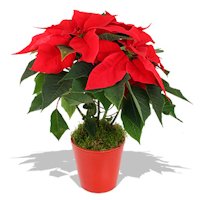
|
Some Common Myths Thought to be True - Myth 52
Myth 52: Poinsettias are Highly Toxic
In the United States and perhaps elsewhere, there is a common misconception that
the poinsettia is highly toxic. This misconception was spread by a 1919 urban
legend of a two-year-old child dying after consuming a poinsettia leaf.
|
| Poinsettia | |
|
Albert Ecke emigrated from Germany to Los Angeles in 1900, opening a dairy and
orchard in the Eagle Rock area. He became intrigued by the plant and sold them
from street stands. His son, Paul Ecke, developed the grafting technique, but
it was the third generation of Eckes, Paul Ecke, Jr., who was responsible for
advancing the association between the plant and Christmas. Besides changing the
market from mature plants shipped by rail to cuttings sent by air, he sent free
plants to television stations for them to display on air from Thanksgiving to
Christmas. He also appeared on television programs like The Tonight Show and
Bob Hope's Christmas specials to promote the plants.
|
|
| ⇦ Back to Myth 51 Return to Myth Choices Page 4 On to Myth 53 ⇨ | |